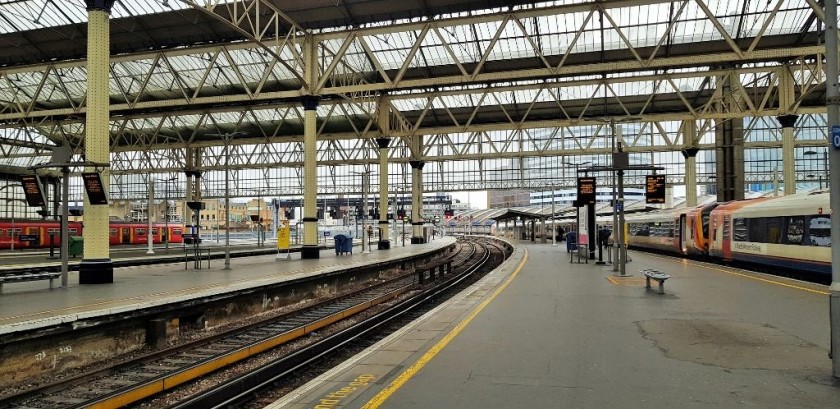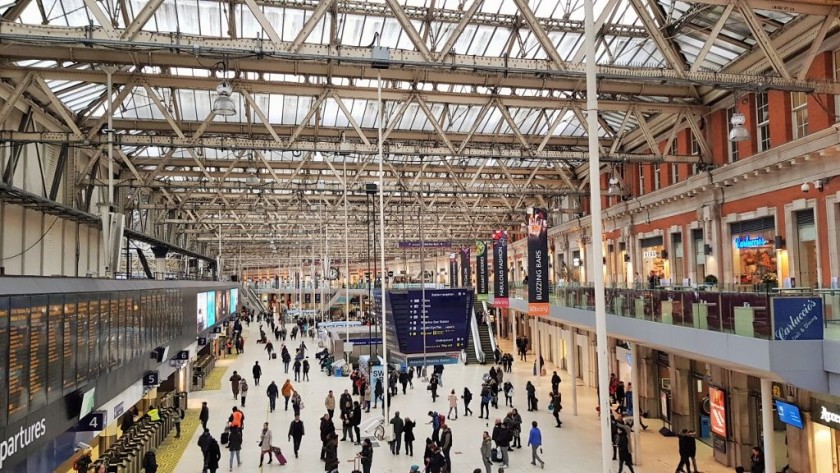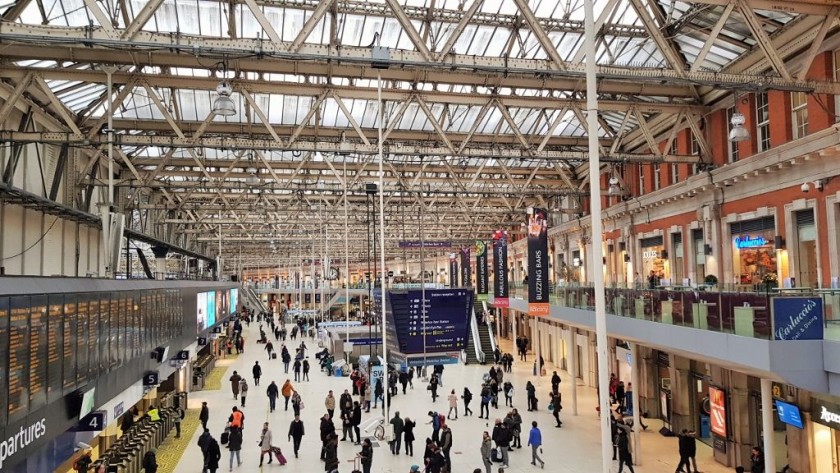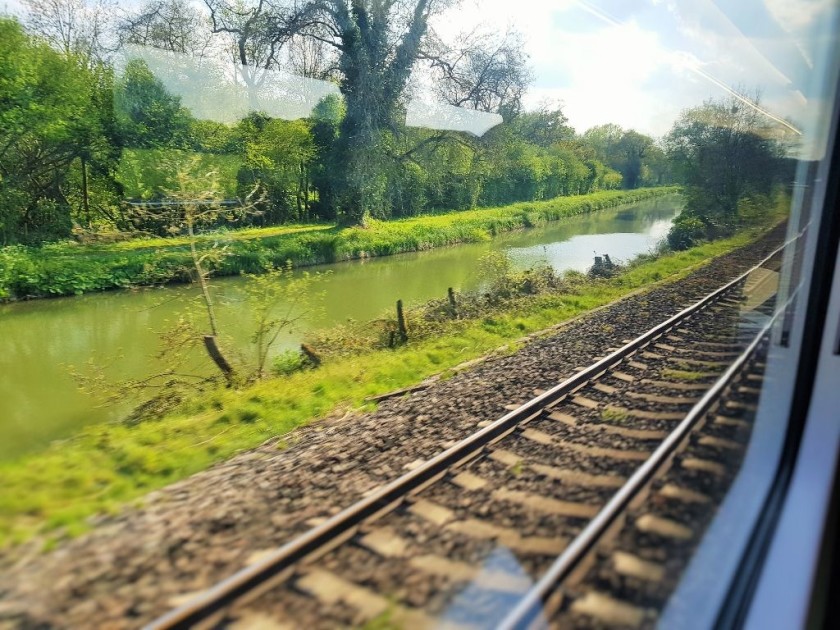Related Content
Content

London Waterloo (London)
With its 24 platforms (tracks) London Waterloo is the UK’s largest station, but as it’s a terminus station the access to and from the trains is straightforward, so despite its size it is also a comparatively uncomplicated station to navigate.
Share
At a Glance
Services
Left Luggage
Travel Information Desk
Local Tourism Information
Onward Travel
Metro
Taxi Rank
Accessibility
Step Free
Misc
Terminus Station









All of the platforms/tracks which the mainline trains arrive at and depart from are linked to the main concourse.
Although what was the Eurostar terminal has recently been adapted, so that it can now accommodate regular train services.
As a result the access to platforms (tracks) 20-24 is set back from the main concourse; and the transfer between the Underground and this part of the station is by a different route, which avoids the main concourse.
What can help make sense of the space is that the trains usually depart from specific sets of platform (tracks) according to their destination, though note there’s some overlap.
Platforms 1 – 6 for the shorter-distance ‘commuter trains’ via Wimbledon to Hampton Court, Chessington, Epsom and Kingston-upon-Thames.
Platforms 5 – 17 are used by the longer-distance to trains to destinations including Bournemouth, Exeter, Portsmouth, Portsmouth, Salisbury, Southampton and Winchester.
Platforms 17 – 24 are where the trains to Ascot, Putney, Richmond and Windsor depart from.
Departing by train:
Taking a train from London Waterloo is comparatively straightforward, though due to the size of the station it’s always a good idea to be there at least five minutes before your train departs.
As seat reservations in the conventional sense aren’t available on any train which leaves Waterloo, if you want to be sure of a seat for your journey, it’s best to be on the concourse and ready to board with your ticket, a minimum of 15 minutes before the train you will be taking will be leaving.
The platform (track) number for each departure will appear on the main departure boards, the concourse is so large that there are two of them, around 10 – 15 minutes prior to departure.
The details of the destination and the calling point of each train will appear first, the departures move across these screens in sequential order, so the details of the train will initially appear on the right.
The platform (track) number will be added later without any fanfare, it usually won’t be announced, so keep an eye on the screens.
So that you’ll be waiting close by the platform that your train will be leaving from, if you will be heading to destinations including Hampton Court, Chessington, Epsom and Kingston-upon-Thames, wait in front of the departure screens above the entrances to platforms 3 – 7.
If you’re going to Ascot, Putney, Richmond and Windsor wait in front of the departure screens above platforms 14– 17.
However, if you’re heading to Bournemouth, Exeter, Portsmouth, Salisbury, Southampton or Winchester, wait in front of either board, as the trains to these destinations use a mix of platforms across the middle of the station.
Something else to watch out for is that two trains serving different destinations can be joined together on departure from Waterloo, the trains will be divided during the journey.
So pay attention to any information alerting you to where specific coaches on a train will be heading to.
And then where you are walking along the platform to board the train, some basic counting may be required, so that you can find the ‘front four coaches’ etc.
Also the trains nearest to the entrances to the platform may not be going anywhere soon, but the train you will be taking will be leaving from the far end of the platform.
This is also another reason for not having to hurry against the clock when taking a train from Waterloo, many of the trains leaving Waterloo are 12 coaches long, so having to rush down to the more distant far end of a platform is a scenario best avoided.
Also try to avoid taking any train from London Waterloo between 16:30 and 19:00 on Monday – Friday.
All of the routes from the station are popular with commuters, so both the stations and trains become a lot busier and crowded during these times.
Arriving by train:
If you won’t be arriving by train at Waterloo in the morning rush hour*, the only usual means of accessing the exits from the station and the Underground, is to go ahead from the train and pass through the ticket gates on to main concourse.
(*If your train arrives at platforms 1 – 18 between 07:00 and 10:00, you’ll be able to access staircases which are a short-cut to the Underground station).
Though if your train arrives at the newly re-opened platforms (tracks) 20 – 24, there are escalators on these platforms, which provide a quicker route to the access to the Bakerloo, Northern and Waterloo and City lines.
Connecting to the Underground:

There are two entrances to the Underground station on the main concourse, that opposite platforms 4 -5 is the quickest route to the Jubilee Line, while the shortest route from the concourse to the Bakerloo, Northern and Waterloo and City lines, is to use the entrance to the Underground which is beside the entrance on the concourse to platform (track) 17.
The Waterloo and City line, which provides a one-stop hop to Bank station is not open on Sundays.
The Bakerloo Line connects Waterloo to
- Piccadilly Circus for Soho and the theatres on Shaftesbury Avenue
- Marylebone; and
- Paddington stations.
The Jubilee Line connects Waterloo to:
- Westminster,
- Green Park for the street named Piccadilly and Mayfair,
- Bond Street for Selfridges,
- Baker Street for Madame Tussaud’s,
- London Bridge for Borough Market and The Shard: and
- North Greenwich for The O2.
The Northern Line connects Waterloo with
- Leicester Square for Covent Garden,
- Tottenham Court Road and;
- Euston station.
If you’ll be heading to Kings Cross or St Pancras stations from Waterloo there is no direct link by Underground, but of all the options available, SMTJ’s preferred route is to take the Bakerloo Line to Piccadilly Circus and then transfer to a northbound Piccadilly Line train.
The Bakerloo Line tends to be quieter than the other Underground lines and the connection at Piccadilly Circus is comparatively short; though the shortest route at Piccadilly Circus isn’t step-free.
For various reasons avoid taking the Northern Line to Warren Street and connecting there for the Victoria Line.
Heading off on foot:
Don’t assume that because Waterloo is on the south bank of the River Thames that it must be some distance from central London.
The River Thames bends as it travels through the city and thanks to this quirk of geography many parts of the city centre can be unexpectedly closer to Waterloo than you might suppose.
Waterloo is also right by the dynamic South Bank area of the city.
A pedestrian walkway is available on the south side of Thames as far east as Tower Bridge and to reach it, use the main exit from Waterloo at the end of the concourse; opposite the bridge to platforms 20-24 - and follow the street signs pointing the way to the Festival Hall.
At a casual pace you can be in Covent Garden, Trafalgar Square or Westminster within 15 mins; and in 25 – 30 mins you can get to St Pauls and Tate Modern.
Heading to the West End of London:
The overwhelming majority of trains to Waterloo also call at Clapham Junction station and from platforms 12 and 14 at this station, there are frequent trains to Victoria Station
That station has more convenient access than Waterloo to the western side of central London.
So if you’ll be heading to Knightsbridge, St James’s Park or Hyde Park it can be worth considering making the connection at Clapham Junction.
Or if your train will be calling at Vauxhall, the longer-distance trains skip this station, it has an easy interchange with the Victoria Line of the Underground – and this line doesn’t serve Waterloo.
If you’ll be heading to South Kensington for its museums and on a train which calls at Wimbledon or Richmond, the best option is to connect at those stations into a District Line train.
Waterloo East station

Waterloo East is a separate station which is connected to the main terminal by a footbridge, which can be accessed from an upper balcony level in the main station.
This upper level across the rear of the terminal, also houses some of the best places to have something to eat and drink while waiting for a train at Waterloo
Waterloo East station is used by South Eastern trains to Canterbury, Dover, Hastings and Tunbridge Wells.
If you’ll be taking the Jubilee Line to connect to these trains alight at Southwark station instead of Waterloo.
Journeys
# Jump to a directionDirections
Journeys from London Waterloo
Jump to directionsLondon to Bournemouth by train
London to Portsmouth by train
London to Exeter by train
London to Salisbury by train

This is one of more than 300 station guides available on ShowMeTheJourney, which will make it easier to take the train journeys you want or need to make. As always, all images were captured on trips taken by ShowMeTheJourney.





